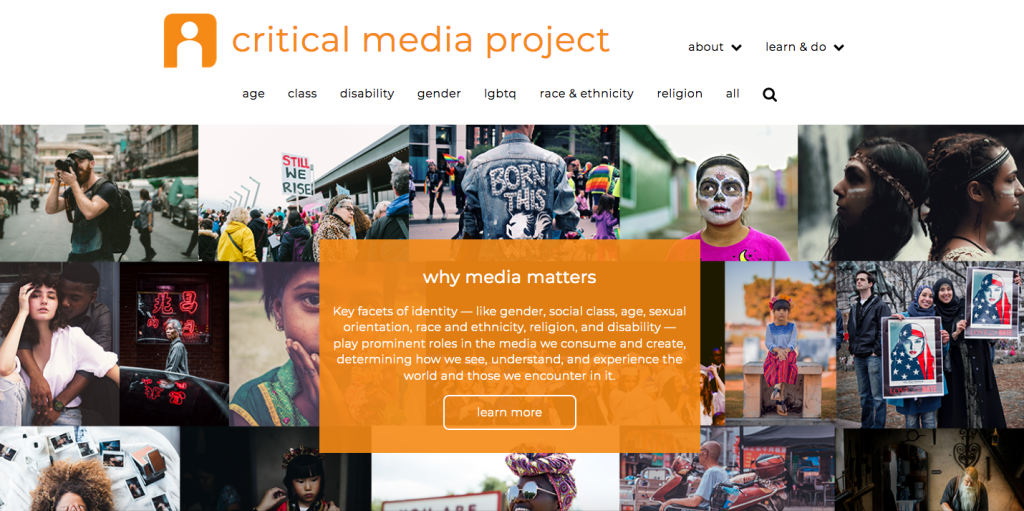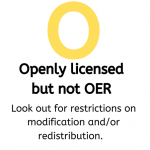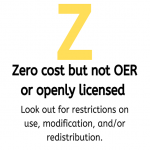Developed by Rianne Subijanto, Department of Communication Studies, Baruch College, CUNY
Professor Subijanto found it easiest to incorporate OER into classroom activities. Even before she was aware of OER, she had been using publicly available sources online during class. As a media historian, she was excited to have access to OER archival sources. Instead of assigning students to go to the library, they could use OER websites to practice archival research.
The OER
 Professor Subijanto found two very helpful websites for classroom activities for classes on media studies.
Professor Subijanto found two very helpful websites for classroom activities for classes on media studies.
The Critical Media Project offers free media literacy web resources that covers themes such as age, class, disability, gender, lgbtq, race and ethnicity, and religion. The Critical Media Project provides worksheets and discussion questions for exploration of various topics. In one of her classes Professor Subijanto invites students to discuss Edward Said’s theory of Orientalism after watching a music video by a Syrian-American artist, Mona Haydar. Explanations on the website illuminate how Haydar pushes against orientalist stereotype of hijabi women and provides students with discussion questions.
Second, Media History Project is a “free online resource, featuring millions of pages of books and magazines from the histories of film, broadcasting, and recorded sound.”
Course Artifacts
This list contains some of the activities Professor Subijanto designed to accompany the reading assignments. The readings are not OER, but OER materials are used for the discussion activities.
Activity: Googlization of everything
Upon reading Brice Nixon’s “The old media business in the new: ‘the Googlization of everything’ as the capitalization of digital consumption,” explore one of the following platforms owned by Google:
Put any keywords of your choice. Describe what is shown on the result. Do you see any ads? What are they? How do the ads specifically target you?
Using the above task, explain how Google exploits digital audience labor and capitalize on users’ digital activities. Do Nixon’s findings resonate with your findings? Why, or why not?
Activity: Symbolic Annihilation of Women
Gaye Tuchman’s “The Symbolic annihilation of women by the mass media” illustrates some analyses on how magazines, newspapers, and television depict stereotypical ideas about women’s roles in the society. She argues that the media’s limited ways of representing women result in:
- Symbolic annihilation of women
- Reflection hypothesis
Reflect on the above themes by exploring one of these magazines:
Do you see a case of “symbolic annihilation” and “reflection hypothesis” in some of the editions of the magazine? Screen shot one example from the magazine, attach it to your answer, and provide your brief analysis. Use the following questions to guide your analysis:
- How are women represented and depicted in the magazine? What images, narratives, and choice of words used when talking about them?
- In thinking about representation, it is equally important to ask “what’s not there?” What is absent in the magazine’s depiction of women?
- What does the images and narratives reveal about the society’s feminine ideal? In other words, what is an “ideal woman” according to the magazine?
- Do you find Tuchman’s concepts of “symbolic annihilation” and “reflection hypothesis” useful to reveal the problem of women’s representation in the media? Why, or why not?
Activity: Commodity activism
Read Sarah Banet-Weiser, “’Free Self-Esteem Tools?”: Brand Culture, Gender, and the Dove Real Beauty Campaign” in Commodity Activism: Cultural Resistance in Neoliberal Times edited by Roopali Mukherjee and Sarah Banet-Weiser, NYU Press, pp. 39-56.
In this forum, we will discuss branding culture and “commodity activism” and how they affect our everyday lives.
Find an advertisement that embodies a form of commodity activism. You can choose either a video ad on Youtube, such as the Dove Real Beauty campaign, or an image ad, such as the one you’d find in an (online) magazine/newspapers (example).
-
- Attach this ad at the beginning of your initial post.
- Explain what images, rhetorics (choice of words, language style, framing, narratives) and other aspects of the ad that make it a form of commodity activism.
- Based on the ad, share your views on “commodity activism.” Do you think it has positive/negative influences on our everyday lives? In what ways?
- Do you find Sarah Banet-Weiser’s argument on commodity activism convincing? Why, or why not?
Activity: How to detect fake news
Read the following articles to submit a “Fake news report”:
- Carl Sagan, “The Fine Art of Baloney Detection” from The Demon-Haunted World: Science as a Candle in the Dark (1996)
- Eric Weiskott, “Before ‘Fake News’ Came False Prophecy” in The Atlantic, Dec 27, 2016
- Andrew Higgins, Mike McIntire, and Gabriel J. X. Dance, “Inside a Fake News Sausage Factory” in The New York Times, Nov 25, 2016
- CUNY J-School’s Fake News Detection Checklist
Find one article online that contains fake news. Using Sagan’s art of baloney detection, identify and explain what sentences, paragraphs, and pictures that contain fallacies in the article. Give a suggestion on what the author of the article can do to avoid making the fallacies.
Faculty Information
Rianne Subijanto is an Assistant Professor in the Department of Communication Studies at Baruch College, CUNY
Licensing INformation
![]() The approach and materials curated for the Media Analysis and Criticism course are licensed under a Creative Commons Attribution-NonCommercial-ShareAlike 4.0 International License.
The approach and materials curated for the Media Analysis and Criticism course are licensed under a Creative Commons Attribution-NonCommercial-ShareAlike 4.0 International License.
 The Critical Media Project and the Media History Project are openly licensed but not OER.
The Critical Media Project and the Media History Project are openly licensed but not OER.
 The readings linked to the activities above are zero cost but not OER or openly licensed.
The readings linked to the activities above are zero cost but not OER or openly licensed.

